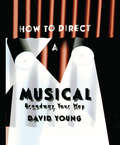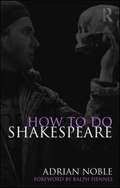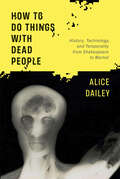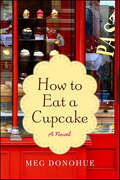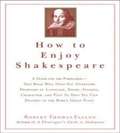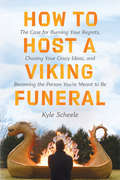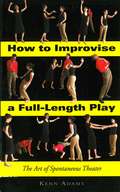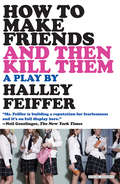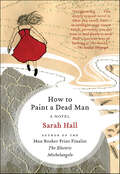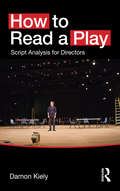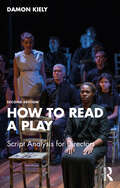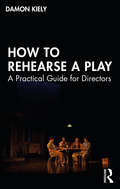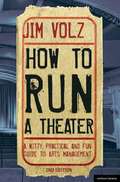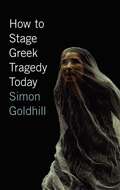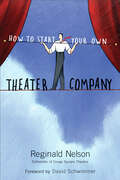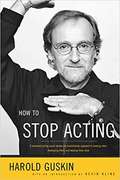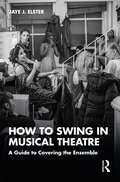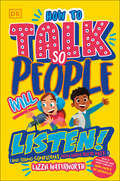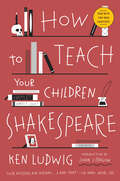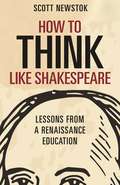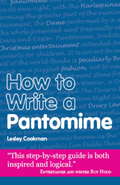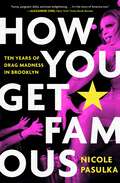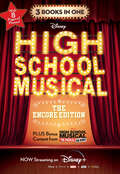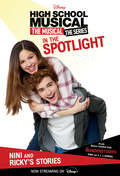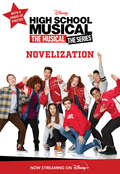- Table View
- List View
How to Direct a Musical
by David YoungHow to Direct a Musical is a lively and practical guide to the seemingly overwhelming task of directing a musical. David Young brings to this handbook his extensive experience as a director of over 100 productions and more than 250 workshops in the US, China, Senegal and Brazil. Young takes a pragmatic, do-it-yourself approach, guiding the reader from planning to casting, rehearsal to opening night. Topics covered include script analysis, collaboration with designers, musical directors, choreographers and crew, eliminating lengthy pauses between scenes, dress rehearsals and curtain calls.
How to do Shakespeare
by Adrian NobleThe author has worked on Shakespeare with everyone from Oscar-nominated actors to groups of schoolchildren. Here he draws on several decades of top-level directing experience to shed new light on how to bring some of theatre’s seminal texts to life. <p><p> He shows you how to approach the perennial issues of performing Shakespeare, including: wordplay – using colour and playing plain, wit and comedy, making language muscular; building a character – different strategies, using the text, Stanislavski and Shakespeare; shape and structure – headlining a speech, playing soliloquys, determining a speech’s purpose and letting the verse empower you; dialogue – building tension, sharing responsibility and ’passing the ball’. <p><p> This guided tour of Shakespeare’s complex but unfailingly rewarding work stunningly combines instruction and inspiration.
How to Do Things with Dead People: History, Technology, and Temporality from Shakespeare to Warhol
by Alice DaileyHow to Do Things with Dead People studies human contrivances for representing and relating to the dead. Alice Dailey takes as her principal objects of inquiry Shakespeare's English history plays, describing them as reproductive mechanisms by which living replicas of dead historical figures are regenerated in the present and re-killed. Considering the plays in these terms exposes their affinity with a transhistorical array of technologies for producing, reproducing, and interacting with dead things—technologies such as literary doppelgängers, photography, ventriloquist puppetry, X-ray imaging, glitch art, capital punishment machines, and cloning. By situating Shakespeare's historical drama in this intermedial conversation, Dailey challenges conventional assumptions about what constitutes the context of a work of art and contests foundational models of linear temporality that inform long-standing conceptions of historical periodization and teleological order. Working from an eclectic body of theories, pictures, and machines that transcend time and media, Dailey composes a searching exploration of how the living use the dead to think back and look forward, to rule, to love, to wish and create.
How to Eat a Cupcake: A Novel
by Meg Donohue“An irresistible blend of sweet and tart, this book is truly a treat to be savored.”—Beth Kendrick, author of The Bake Off and Second Time Around“A sparkling, witty story about an unlikely, yet redemptive, friendship….Grab one of these for your best friend and read it together—preferably with a plate of Meyer Lemon cupcakes nearby.”—Katie Crouch, bestselling author of Girls in Trucks and Men and DogsAuthor Meg Donohue has cooked up an absolutely scrumptious debut novel, How to Eat a Cupcake, that explores what happens when two childhood friends, Annie and Julia, reconnect as adults and decide to open a cupcakery. But success in their new baking business venture will depend upon their overcoming old betrayals, first loves, and an unexpected and quite dangerous threat. Donohue’s How to Eat a Cupcake is contemporary women’s fiction at its smartest, sweetest, and most satisfying, joining the ranks of The Recipe Club, The School for Essential Ingredients, and Joanne Harris’s classic Chocolat by proving once again that fiction and food make an unbeatable combination.
How to Enjoy Shakespeare
by Robert Thomas FallonIn How to Enjoy Shakespeare, the author explores Shakespeare's familiarity in five sections dealing with language, theme, staging, character, and plot, each abundantly illustrated with episodes and quotations from the plays.
How to Host a Viking Funeral: The Case for Burning Your Regrets, Chasing Your Crazy Ideas, and Becoming the Person You're Meant to Be
by Kyle ScheeleAn inspiring speaker and artist asked 20,000 people around the world to share the regrets they wanted him to burn in a mock Viking ship. This is the story of what he learned about letting go of the pain of the past and embracing the future with hope.Turning 30, artist and speaker Kyle Scheele wanted to do something unusual to mark this milestone. Instead of a birthday bash, he decided to hold a funeral to memorialize the decade of his life that was ending. Building a 16-foot Viking ship out of cardboard, he invited friends to help him set it on fire—a symbolic farewell to his 20s and all the grief, regret, and mistakes that accompanied those years. When video of his Viking funeral went viral, it encouraged many others to let go of past hurts as well. Moved by the response he received, Kyle planned a second funeral (this time with a 30-foot cardboard Viking ship) and asked people to share the things they carried—the bad choices, disappointments, heartaches, and negative thinking that they wanted to lay to rest. He received more than 20,000 responses from around the world—stories both heartbreaking and hilarious, painful and inspiring. In this entertaining and wise book, Kyle reflects on what he discovered about freeing ourselves from the pain of the past, interweaving anecdotes from those who participated with the story of his own journey of renewal. “This story involves multiple Viking funerals, thousands of square feet of cardboard, and enough hot glue to supply your mother-in-law's craft night for the rest of time,” he writes. “But it also involves regret, self-doubt, insecurity, and ultimately, redemption. So buckle up. It's about to get bumpy.”How to Host a Viking Funeral is the story of letting go of the people we used to be, but no longer want to be. It’s about renewal; where there was once regret there is now blank space—an opportunity for a fresh start.
How to Improvise a Full-Length Play: The Art of Spontaneous Theater
by Kenn AdamsForget the script and get on the stage! In How to Improvise a Full-Length Play, actors, playwrights, directors, theater-group leaders, and teachers will find everything they need to know to create comedy, tragedy, melodrama, and farce, with no scripts, no scenarios, and no preconceived characters. Author Kenn Adams presents a step-by-step method for long-form improvisation, covering plot structure, storytelling, character development, symbolism, and advanced scene work. Games and exercises throughout the book help actors and directors focus on and succeed with cause-and-effect storytelling, raising the dramatic stakes, creating dramatic conflict, building the dramatic arc, defining characters, creating environments, establishing relationships, and more. How to Improvise a Full-Length Play is the essential tool for anyone who wants to create exceptional theater.
How To Make Friends and Then Kill Them: A Play
by Halley FeifferThe uproarious and borderline repulsive play about two neglected sisters and their oddball friend by the author of I’m Gonna Pray For You So Hard. Left to their own devices by their alcoholic mother, Ada and Sam cultivate an insular world into which they soon draw a third wheel – a pockmarked, limping wallflower named Dorrie. In the years spanning childhood to young adulthood, these three troubled girls learn to lean on each other completely, finding ways to fill each other up and to tear each other down. But when a horrible accident turns their reality upside down, they find they must decide whether they will continue to foster their familiar, codependent cycle, or whether they will break free, with or without each other’s aid.
How to Paint a Dead Man: A Novel
by Sarah Hall"Hall's writing manages to combine acute sensitivity and daring. ... Visceral and engaging. ... The emotional lives of her characters are skillfully realized in this bright weave of disparate voices–for whom art is at once a way of seeing and a way of life." —The Times (London)The lives of four individuals—a dying painter, a blind girl, a landscape artist, and an art curator—intertwine across nearly five decades in this luminous and searching novel of extraordinary power. With How to Paint a Dead Man, , Sarah Hall, "one of the most significant and exciting of Britain's young novelists" (The Guardian), delivers "a maddeningly enticing read...an amazing feat of literary engineering" (The Independent on Sunday).
How to Read a Play: Script Analysis for Directors
by Damon KielyThe work done on a play before the first rehearsal, the first group reading or even the before the cast have met, can be crucial to the success of a production. Directors and dramaturgs must know how to analyze, understand and interpret a play or performance text if they hope to bring it to life on the stage. This book provides a broad range of tools and methods that can be used when reading a text, including: Lessons from the past. What can we learn from Aristotle, Stanislavsky, Meyerhold, Vakhtangov, Brecht and Harold Clurman? This section establishes the models and methods that underpin much of a director’s work today. A survey of current practices in Western theatre. A combination of research, interviews and observation of practical work addresses the main stages in understanding a play, such as getting to know characters, sharing ideas, mapping the action and grappling with language. A workbook, setting out twenty one ways of breaking down a play, from the general to the particular. Contributions, reflections and interjections from a host of successful directors make this the ideal starting point for anyone who wants to direct a play, or even devise one of their own. This wide range of different approaches, options and techniques allows each reader to create their own brand of play analysis.
How to Read a Play: Script Analysis for Directors
by Damon KielyNow in a fully updated second edition, How to Read a Play offers methods for analyzing play scripts from a diverse range of perspectives, giving directors practical tools as they prepare for production.Based on interviews with award-winning directors, university professors, and experimental theatre companies, How to Read a Play provides practical advice on how to first approach a script, prepare for design meetings, get ready for casting sessions, and lay the groundwork for rehearsals with actors. The book starts with a brief historical overview of famous directors, surveys the work of experimental theatres that devise their work, and ends with twenty-one practical exercises. The second edition includes material from interviews with a diverse range of directors and features perspectives on identity, race, trauma, and joy in working on new plays and redefined classic works.How to Read a Play is written for anyone who loves studying the craft of directing. Students and early career directors will be introduced to basic techniques for breaking down a script for production. Established artists will enjoy a behind the scenes peek at the methods and processes of directors with a diverse range of perspectives.
How to Rehearse a Play: A Practical Guide for Directors
by Damon KielyBased on interviews with over forty award-winning artists, How to Rehearse a Play offers multiple solutions to the challenges that directors face from first rehearsal to opening night. The book provides a wealth of information on how to run a rehearsal room, suggesting different paths and encouraging directors to shape their own process. It is divided into four sections: lessons from the past: a brief survey of influential directors, including Stanislavski’s acting methods and Anne Bogart’s theories on movement; a survey of current practices: practical advice on launching a process, analyzing scripts, crafting staging, detailing scene work, collaborating in technical rehearsals and previews, and opening the play to the public; rehearsing without a script: suggestions, advice, and exercises for devising plays through collaborative company creation; rehearsal workbook: prompts and exercises to help directors discover their own process. How to Rehearse a Play is the perfect guide for any artist leading their first rehearsal, heading to graduate school for intense study, or just looking for ways to refresh and reinvigorate their artistry.
How To Run A Theatre: A Witty, Practical And Fun Guide To Arts Management
by Jim VolzThe first edition of How to Run a Theatre sold out within months of initial publication and it took the cries of the field and pleadings of professors who use the book in their university classes to encourage me to search for a publisher for this second edition. <P><P>Fortunately, publisher Jenny Ridout with London's esteemed Methuen Drama/A & C Black Publishers Limited took time to review the book and take it to her Board. The results are before you - an updated edition with new sections, new contacts and new teaching tools.
How to Stage Greek Tragedy Today
by Simon GoldhillFrom the stages of Broadway and London to university campuses, Paris, and the bourgeoning theaters of Africa, Greek tragedy remains constantly in production. This global revival, in addition to delighting audiences, has highlighted both the promise and the pitfalls of staging ancient masterpieces in the modern age. Addressing the issues and challenges these performances pose, renowned classicist Simon Goldhill responds here to the growing demand for a comprehensive guide to staging Greek tragedy today. In crisp and spirited prose, Goldhill explains how Aeschylus, Euripides, and Sophocles conceived their works in performance and then summarizes everything we know about how their tragedies were actually staged. The heart of his book tackles the six major problems facing any company performing these works today: the staging space and concept of the play; the use of the chorus; the actor’s role in an unfamiliar style of performance; the place of politics in tragedy; the question of translation; and the treatment of gods, monsters, and other strange characters of the ancient world. Outlining exactly what makes each of these issues such a pressing difficulty for modern companies, Goldhill provides insightful solutions drawn from his nimble analyses of some of the best recent productions in the United States, Britain, and Continental Europe. One of the few experts on both Greek tragedy and contemporary performance, Goldhill uses his unique background and prodigious literary skill to illuminate brilliantly what makes tragedy at once so exciting and so tricky to get right. The result will inspire and enlighten all directors and performers—not to mention the growing audiences—of ancient Greek theater.
How to Start Your Own Theater Company
by Reginald Nelson David SchwimmerWith hands-on advice and instruction from an experienced actor and theater director, this pragmatic, authoritative guide to starting a theater company imparts essential backstage know-how for would-be playhouse practitioners on everything from fundraising and finding a space to selecting plays and successfully navigating tricky legal issues. Chronicling three seasons at Chicago's award-winning Congo Square Theatre Company, this journey behind the curtain reveals the nitty-gritty details of practical issues that are often overlooked amidst the zeal of artistic pursuit, such as how to manage rent, parking, and safety issues; determine tax status and calculate budgets; and find flexible day jobs to help foster artists' creative passion. The guide also provides in-depth analysis of undertaking lofty projects--such as managing a coproduction with a large, established theater, as Congo Square did with Tony Award-winning Steppenwolf Theatre Company--and addresses potential drawbacks, such as handling common weaknesses of the "artistic temperament" that can often lead to a business venture's undoing. Inspired by Congo Square's own unique inception, the valuable how-to also speaks directly to the many underserved niche audiences who decide to create their own companies, including African American, Asian American, Latino, physically challenged, and GLBT communities. Concluding with lists of Equity offices, legal advisers, and important organizations for assistance, this complete resource is sure to help ambitious theater lovers establish and maintain their own successful companies.
How to Stop Acting: A Renowned Acting Coach Shares His Revolutionary Approach to Landing Roles, Developing Them and Keeping Them Alive
by Harold Guskin Kevin KlineHarold Guskin is an "acting doctor" whose clients include Kevin Kline, Glenn Close, James Gandolfini, Bridget Fonda, and dozens more. In How to Stop Acting, Guskin reveals the insights and techniques that have worked wonders for beginners as well as stars. Instead of yet another "method," Guskin offers a strategy based on a radically simple and refreshing idea: that the actor's work is not to "create a character" but rather to be continually, personally responsive to the text, wherever his impulse takes him, from first read-through to final performance. <p><p> From this credo derives an entirely new perspective on auditioning and the challenge of developing a role and keeping it fresh, even over hundreds of performances. Drawing on examples from his clients' work and his own, Guskin presents acting as a constantly evolving exploration rather than as a progression toward a fixed goal. He also offers sound and original advice on adapting to the particular demands of television and film, playing difficult emotional scenes, tackling the Shakespearean and other great roles, and more. His book will find an eager and appreciative audience among novices and established actors alike.
How to Swing in Musical Theatre: A Guide to Covering the Ensemble
by Jaye J. ElsterHow to Swing in Musical Theatre shines a light on the most universal techniques used by cast members who, in response to absence, can perform multiple roles across an ensemble. This entertaining guide can be used not only to build a step-by-step understanding of what swinging is and how it can be approached, but also as a constant point of reference throughout a career in musical theatre. Providing a suite of practical, technical advice on everything from quick and easy notation to compiling one’s own personal swing ‘bible’, everything that an aspiring or experienced musical theatre performer will need is clearly arranged and thoughtfully explained. This book also teaches the SAFE Strategy, which is recognised as the most functional swing method and introduces the SAFE Principles of Swinging: Safety, Awareness, Function and Evolution. The principles are an original construct, devised to ward off stress and invite positive experience through reasoned behaviours. Musical theatre performers at every level of the profession will find this an invaluable guide that elevates their craft no matter what their previous training, experience or success in the industry.
How To Talk So People Will Listen: And Sound Confident (Even When You’re Not)
by Lizzie WaterworthFind your voice and own the room, even when your legs are shaking!Professional cartoon voice artist Lizzie Waterworth tells you all about her strategies for confident speaking, from breathing exercises to what to do with your hands, and how to conquer that pesky inner voice that whispers "what if...?".Packed with funny stories from Lizzie's world of cartoons, and top tips from a host of professional voice artists and public figures, such as Stephen Fry, David Menkin, and BBC presenter Ben Shires, this book is full of practical advice to help you find your voice!'We teach our children reading and writing but we forget listening and speaking, which are essential life skills. Lizzie brilliantly fills that gap for speaking in this fun, easy to read manual for children of all ages (and parents too!). Every child should have this!' - Julian Treasure, top-10 TED speaker and author of How To Be Heard'The book looks really brilliant - I will definitely be using it for homework sessions with my younger ones.' - Dr Natalie Cawley, counselling psychologist and psychotherapist'Lizzie has a terrific way of helping folks overcome natural fears about speaking in front of others, and this book very much captures her spirit and energy. In How to Talk so People Will Listen, she draws on her professional knowledge and experience to treat the topic seriously while also making it fun.' - James Tierney, Yale University English Language Programs'This book is perfect for helping young ones learn essential skills and grow self-confidence all whilst having fun reading!' - Claudia Dalley, Head of POP Channels'This book is great because it's instructional without being full of jargon...and it's funny too! Definitely one for children and adults even!' - Monique Berry, Headteacher'It&’s like a cartoon on the outside and inside the playfulness continues. I really think this book is an invaluable resource. Although this book is designed for young people, Lizzie&’s advice is applicable to people of any age.' - Ranny Levy, Founder and President, KIDS FIRST! / Coalition for Quality Children's Media
How to Teach Your Children Shakespeare
by Ken LudwigA foolproof, enormously fun method of teaching your children the classic works of William Shakespeare, by a Tony Award–winning playwright—now featuring two new chapters &“You and your children will be transformed by the magic and mystery of Shakespeare and his stories in an instant.&”—Sir Derek Jacobi, CBE Winner of the Falstaff Award for Best Shakespeare BookTo know some Shakespeare provides a head start in life. His plays are among the great bedrocks of Western civilization and contain the finest writing of the past 450 years. Many of the best novels, plays, poems, and films in the English language produced since Shakespeare&’s death in 1616—from Pride and Prejudice to The Godfather—are heavily influenced by Shakespeare&’s stories, characters, language, and themes. In How to Teach Your Children Shakespeare, acclaimed playwright Ken Ludwig provides the tools you need to inspire an understanding, and a love, of Shakespeare&’s works in your children, and to have fun together along the way.Ken Ludwig devised his friendly, easy-to-master methods while teaching his own children. Beginning with memorizing short passages from the plays, his technique then instills children with cultural references they will utilize for years to come. Ludwig&’s approach includes understanding of the time period and implications of Shakespeare&’s diction as well as the invaluable lessons behind his words and stories. Colorfully incorporating the history of Shakespearean theater and society, How to Teach Your Children Shakespeare guides readers on an informed and adventurous journey through the world in which the Bard wrote.This book&’s simple process allows anyone to impart to children the wisdom of plays like A Midsummer Night&’s Dream, Twelfth Night, Macbeth, and Romeo and Juliet. And there&’s fun to be had throughout. Shakespeare novices and experts and readers of all ages will each find something delightfully irresistible in How to Teach Your Children Shakespeare.
How to Think like Shakespeare: Lessons from a Renaissance Education (Skills For Scholars Ser.)
by Scott NewstokA lively and engaging guide to vital habits of mind that can help you think more deeply, write more effectively, and learn more joyfullyHow to Think like Shakespeare offers an enlightening and entertaining guide to the craft of thought—one that demonstrates what we've lost in education today, and how we might begin to recover it. In fourteen brief, lively chapters that draw from Shakespeare's world and works, and from other writers past and present, Scott Newstok distills vital habits of mind that can help you think more deeply, write more effectively, and learn more joyfully, in school or beyond.Challenging a host of today's questionable notions about education, Newstok shows how mental play emerges through work, creativity through imitation, autonomy through tradition, innovation through constraint, and freedom through discipline. It was these practices, and a conversation with the past—not a fruitless obsession with assessment—that nurtured a mind like Shakespeare's. And while few of us can hope to approach the genius of the Bard, we can all learn from the exercises that shaped him.Written in a friendly, conversational tone and brimming with insights, How to Think like Shakespeare enacts the thrill of thinking on every page, reviving timeless—and timely—ways to stretch your mind and hone your words.
How to Write a Pantomime (Secrets to Success)
by Lesley CookmanThere are thousands of pantomimes staged throughout the world every year, most of them in Britain. Most groups, whether they be amateur drama societies, schools, Women's Institutes or Village Hall committees are constantly on the lookout for something fresh and original. This is often a matter of economics, as professional pantomimes can be costly in terms of performing rights, let alone the cost of scripts. This book is aimed at those people who take part in this increasingly popular hobby, and at the writer who wishes to write a pantomime, either for a local group, or, indeed, for mass publication.
How You Get Famous: Ten Years of Drag Madness in Brooklyn
by Nicole PasulkaA madcap adventure through a tight-knit world of drag performers making art and mayhem in the greatest city on earth.Ten years ago, an aimless coat check girl better known today as Merrie Cherry sweet-talked her boss into giving her $100 to host a drag show at a Brooklyn dive bar. Soon, kids like Aja were kicking their way into the scene, sneaking into clubs, pocketing their tips to help mom pay the mortgage, and sharing the stage with electric performers like Thorgy Thor and Sasha Velour. Because suddenly, in the biggest, brightest city in America, drag was offering young, broke, creative queer people a chance at real money—and for thousands or even millions of people to learn their names. In How You Get Famous, journalist Nicole Pasulka joyfully documents the rebirth of the New York drag scene, following a group of iconoclastic performers with undeniable charisma, talent, and a hell of a lot to prove. The result is a sweeping portrait of the 21st-century search for celebrity and community, as well as a chronicle of all the struggles, fights, and disappointments along the way. A rollicking account of the quest to make a living through an art form on the cusp of becoming a cultural phenomenon, How You Get Famous offers an unmissable romp through the gritty and glamorous world of Brooklyn drag.
HSMTMTS: High School Musical: The Encore Edition Junior Novelization Bindup
by Disney Book GroupRelive the magic of High School Musical. Popular star basketball player Troy Bolton and academically gifted beauty Gabriella Montez come from different worlds at East High. But when they both decide to audition for the school musical, magic happens! Follow Troy, Gabriella, and their friends as they navigate high school together in the Encore Edition of the junior novelizations from this beloved trilogy.
HSMTMTS: In the Spotlight: Nini and Ricky's Stories
by Carin DavisNini and Ricky have a history that started way before they won the lead roles of Troy and Gabriella in East High's production of High School Musical. This junior novel, told in alternating first-person narrative by Nini and Ricky, explores their long-time friendship and recently ended romance. But has the curtain really closed on this engaging tale of first love?
HSMTMTS: Novelization, Season 1
by Disney BooksA group of students who attend the Utah high school where the original High School Musical movies were filmed prepare for their fall production of High School Musical. Ricky and Nini, who play Troy Bolton and Gabriella Montez, share chemistry on and off the stage, but with their understudies EJ and Gina plotting to take over their roles, will these talented performers make it to opening night?
